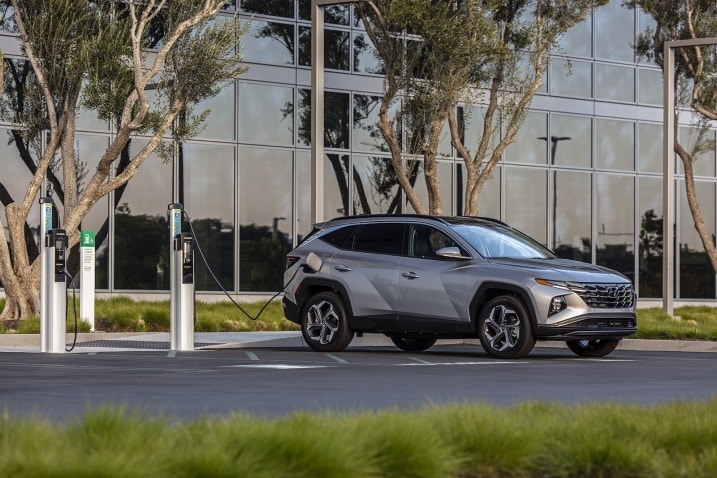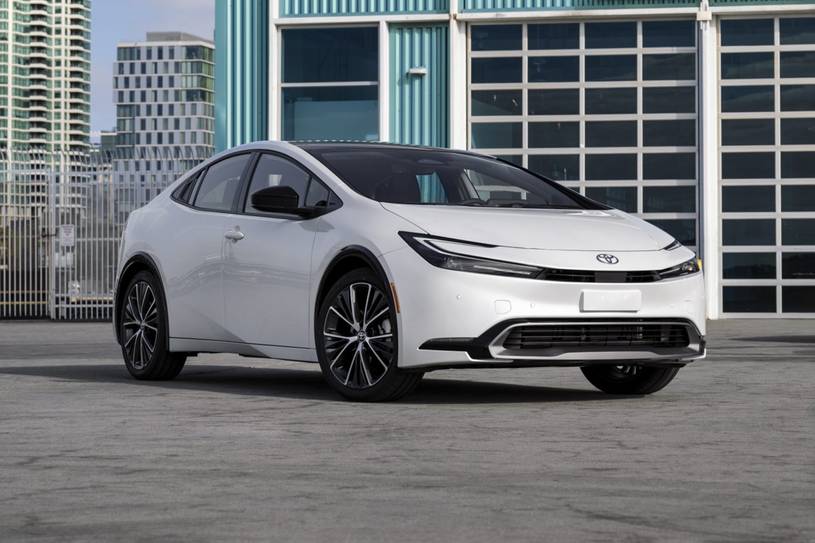Hybrid vehicles have been around for over 20 years and are only getting more common. They are the go-to vehicle for car shoppers wanting to reduce their fuel consumption and their vehicle's emissions. But how do they work, and what's the difference between a hybrid and a plug-in hybrid? Here, we'll outline the differences and help you decide not only what type of hybrid is right for you, but how much more you can expect to pay. We'll also discuss mild hybrids and electric vehicles to help you get a better understanding of the green car landscape. So if you're in the market for a hybrid, keep reading before you head over to your local dealership.
Hybrid vs. Plug-in Hybrid Cars: What's Right for You?
Hybrids
Hybrids, also referred to as hybrid electric vehicles (HEVs), are powered by a gas engine plus an electric motor that gets its power from a battery pack. The engine and electric motor work in tandem to power the vehicle, which results in improved fuel efficiency since the gas engine only runs when needed. At low speeds, only the electric motor powers the wheels, and once the vehicle picks up speed, the gas engine kicks on. When the hybrid is coming to a stop, the gas engine turns off. However, when a lot of power is needed, such as when accelerating hard or climbing a hill, both the motor and engine send power to the wheels. The vehicle's onboard computer controls how much power is needed and when. All you do is drive normally.
Regular hybrids never have to be plugged in to charge the battery. They are like gas cars in the sense that you just hop in and go, and when the fuel gets low, you fill it with gas like a standard gas-powered car. Instead of getting power from an outside source like a charger, the small battery pack is partly charged by regenerative braking. When you press the brake pedal, a second electric motor (most hybrids have two motors) acts as a generator and sends power to the battery pack — power that would have been wasted as brake heat in a non-hybrid vehicle. When the battery pack needs additional energy, the gas engine powers the generator, which then charges the battery.
Hybrids are usually most efficient in stop-and-go driving and least efficient at steady highway speeds. Most hybrids have an electric driving range of only about 1-3 miles at low speeds because of their small battery pack. Plug-in hybrids have a much longer electric driving range.
See Edmunds pricing data
Has Your Car's Value Changed?
Used car values are constantly changing. Edmunds lets you track your vehicle's value over time so you can decide when to sell or trade in.

Plug-in hybrids
Plug-in hybrids, also called plug-in hybrid electric vehicles (PHEVs), are much like regular hybrids but have a significantly larger battery pack that, depending on the model, provides an all-electric driving range of about 15-50 miles. This means it drives like an electric vehicle until its battery becomes low on charge. When that happens, the gas engine kicks on and it operates like a regular hybrid.
Plug-in hybrids are essentially the middle ground between regular hybrids and electric vehicles, providing the best of both worlds. Since the battery pack is large, a plug-in hybrid needs to be plugged in and charged like an EV in order to take advantage of the electric driving range. But unlike an electric vehicle, it can run like a regular hybrid if the battery isn't charged. This allows owners to run mostly on electric power around town if it's charged regularly and take long road trips without the added dread of range anxiety.
Charging daily is the ideal and most efficient way to use a plug-in hybrid. If your PHEV is charged daily and driven within the electric range limit, trips to the gas station can be rare. It's also important to charge PHEVs as often as possible. That's because the large battery pack increases the vehicle's weight, and you'd be lugging around extra heft for no reason, thus worsening your fuel consumption compared to a regular hybrid car.
Fortunately, since a plug-in hybrid battery is a lot smaller than an electric vehicle's battery pack, you can use the charging cord that comes with the vehicle and plug it into a regular 120-volt outlet (the same type that powers and charges most electronics). This is referred to as Level 1 charging. You can also opt for a quicker-charging Level 2 home charger that uses a 240-volt outlet, but you'll have to pay for a charging station and, in some cases, for the installation of the 240-volt outlet. If you're considering purchasing an electric vehicle in the future, a plug-in hybrid will give you a good idea of what it's like to own one.
What type of hybrid is right for you?
If you don't park near a power outlet and want a car that drives much like a traditional gas-powered car, go for a hybrid. You don't have to worry about charging, and if you're on a tight budget, these cars are usually more affordable than a plug-in hybrid. There are also more hybrid models on sale to choose from. Also, if you take long road trips frequently, a hybrid will return better fuel economy since PHEVs tend to lose their electric range quickly at highway speeds.
A plug-in hybrid might make more sense if you are able to charge it every day, have a daily commute that's about as long as the electric range of the model you're considering, don't regularly travel out of town, and can afford its higher price tag. A plug-in hybrid is also ideal for those who want to help reduce tailpipe emissions but aren't ready for a fully electric vehicle.
How much more do hybrids and plug-in hybrids cost?
Hybrids often cost more than their non-hybrid counterparts, although the cost difference has decreased over the years. For example, the price difference between a Toyota Corolla LE and a Corolla Hybrid LE is only $1,450. But with the RAV4 and RAV4 Hybrid, the price difference between the base models is $3,050, although the hybrid model also includes all-wheel drive. The price difference between hybrid and non-hybrid models of the Kia Sportage LX is only $1,400, but with its corporate cousin, the Hyundai Tucson, the price difference between the base models is significant: $5,075.
Plug-in hybrids cost more than regular hybrids because of their larger battery pack and more powerful motor. And in most cases, plug-in hybrid models are only available in higher trim levels that have more features. The price difference is usually significant but could be partly offset by the tax incentive that some qualify for, as you'll see below. The Toyota Prius is a hybrid, but it's also available as a plug-in hybrid called the Prius Prime. The base Prius Prime costs $5,025 more than the base Prius model. The price difference between the hybrid and plug-in hybrid variants of the Toyota RAV4 and Kia Sportage is over $10,000.
Since the price differences between hybrids and plug-in hybrids vary, it's best to compare different models before you decide which route to go.
Do hybrids and plug-in hybrids qualify for federal tax credits?
Regular hybrids do not qualify for a federal tax credit, but plug-in hybrids do. But if you buy a new plug-in hybrid in 2024, only a few models qualify for a $3,750 tax credit. They include the Ford Escape Plug-in Hybrid, the Jeep Grand Cherokee 4xe, the Jeep Wrangler 4xe and the Lincoln Corsair Grand Touring. The Chrysler Pacifica Plug-in Hybrid qualifies for $7,500. If you lease a plug-in hybrid, all models qualify for a $7,500 tax credit. If you buy a used plug-in hybrid, you can get a tax credit of up to $4,000. Starting in 2024, shoppers can turn the tax credit into a point-of-sale discount. For full details, check out our article about the ins and outs of electric vehicle tax credits.
What is a mild hybrid?
A mild hybrid, or mild hybrid electric vehicle (MHEV), is mostly powered by a gas engine, but a small motor and battery pack offer assistance that results in a modest fuel efficiency and performance gain. Unlike regular hybrids that have a larger high-voltage battery pack that can propel the vehicle, the smaller battery pack of a mild hybrid is only 48 volts and isn't powerful enough to propel the vehicle on its own. Instead, a mild hybrid system usually replaces a traditional starter and alternator, and it powers the vehicle's electronics such as the air conditioner and radio without the help of the engine. A mild hybrid system also assists the engine during acceleration by giving it a temporary boost in power. Many brands offer vehicles with mild hybrid systems, and they typically cost less than a full hybrid or plug-in hybrid.
What about electric vehicles?
Electric vehicles, or EVs, do not have a gas engine and rely solely on electric power. They are powered by a battery pack that's significantly larger than a hybrid's or plug-in hybrid's and are propelled by anywhere from one to four motors that are much more powerful than the units found in any type of hybrid. Since EVs lack a gas engine, they must be charged regularly. In most cases, you won't be able to get away with charging via a 120-volt outlet unless your daily commute is very short. EVs usually require the installation of a Level 2 home charger. If you can't charge at home or at work regularly, then you must rely on public Level 3 fast-charging stations if they are in your area. However, the ideal way to charge an EV is at home because it's more convenient and more affordable than using a public charging station.
Edmunds says
With stricter upcoming fuel regulations and the automotive industry's transition to electric vehicles, expect more hybrids and plug-in hybrids to hit the market over the next several years. Plug-in hybrids aren't suitable for everyone, but anyone can own a hybrid, and there are many models to choose from. Check out our list of the best hybrids and plug-in hybrids here.
Related Links:
Edmunds' top-ranked EVs
Edmunds' top-ranked hybrids and plug-in hybrids
Edmunds' EV super test
Edmunds Tested: Electric Car Range and Consumption



 by
by 